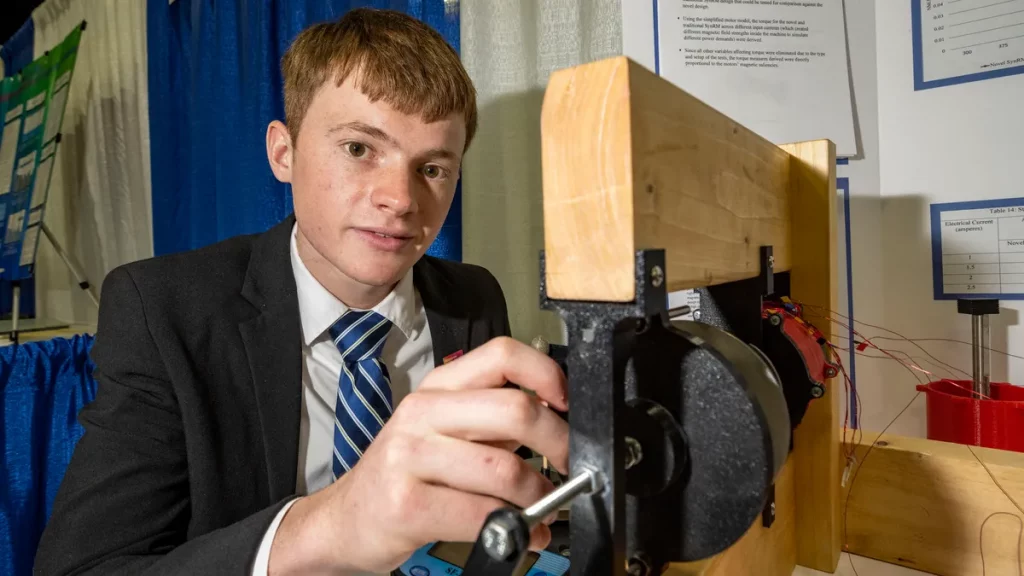Engineer-by-nature, Robert Sansone is a genius. In Fort Pierce, FL the 17 year old inventor has accomplished, by his estimation, at least 60 separate engineering projects, ranging from animatronic hands to high-speed running boots and a go-kart capable of speeds of more than 70 miles per hour.
Sansone stumbled onto a video comparing and contrasting the benefits and drawbacks of electric cars a few years back. Rare-earth magnets, as the video showed, are necessary for most electric vehicle engines, although their extraction comes at a high cost. The required rare-earth elements can cost hundreds of dollars per kilogram. Copper, by contrast, fetches $7.83 per kilogram.


The high schooler was familiar with the synchronous reluctance motor, a form of electric motor that does not require these rare-earth elements. Current applications for this type of motor include pumps and fans; however, it lacks the power necessary to be employed in an electric vehicle on its own. Sansone began to consider how he could enhance its functionality.
Sansone spent a year developing a prototype of a revolutionary synchronous reluctance motor with better torque (rotational force) and efficiency than previous ones. The prototype was constructed out of 3-D printed plastic, copper wiring, and a steel rotor and tested using a variety of power meters and a laser tachometer to determine the motor’s rotational speed.
This year, he won the Regeneron International Science and Engineering Fair (ISEF), the world’s largest high school science, technology, engineering, and math (STEM) competition, and a whopping $75,000 in prize money for his efforts.
Professor of electrical and computer engineering at the University of Michigan, Heath Hofmann notes that the materials used in the less sustainable permanent magnet motors are in great demand due to their use in several goods, including headphones and earbuds. Hofmann has done substantial work on EVs, including consulting for Tesla on the development of the control algorithms for its propulsion motor.
According to him, the use of magnets appears to be expanding into more fields. Since many of the raw materials come from Chinese mines, the cost is highly variable depending on our country’s trade relationship with China. Hofmann says that Tesla’s motors have only recently started to use permanent magnets.
A rotor is rotated by an electric motor’s electromagnetic field, which also rotates. These electromagnetic fields are generated by coils of wire in the motor’s immobile outer part, called the stator. Magnets affixed to the rim of a whirling rotor create a magnetic field that is attracted to the rotor’s opposite poles in permanent magnet motors. The rotor is spun by the attraction.
Magnetic flux is not required for operation in synchronous reluctance motors. Instead, a steel rotor with air spaces carved into it synchronizes with the changing magnetic field. The reluctance of a substance, which is how magnetic it is, is a key part of this process. Torque is generated as the rotor rotates in tandem with the magnetic field. The saliency ratio, or the difference in magnetism between materials (here, the steel and the non-magnetic air gaps), determines the amount of torque generated.
Sansone reasoned that he could eliminate the need for air gaps in a motor by adding another magnetic field. More torque would be generated, as this would improve the saliency ratio. He can’t say much more than that since he plans to patent the technology behind his design in the long run and he doesn’t want to give away any of his secrets.
It was necessary for Sansone to “perform some prototyping to attempt to see if that design would actually function” once he came up with his initial concept. “I don’t have tons of resources for making very advanced motors, and so I had to make a smaller version—a scale model—using a 3-D printer”
It took him several iterations of a prototype to get his final design to the point where he could test it.
He explains, “I didn’t have a mentor to help me, really, so each time a motor failed, I had to do tons of research and try and troubleshoot what went wrong.” “But eventually, on the 15th motor, I was able to get a working prototype.”
After Sansone’s motor passed the torque and efficiency tests, he rewired it to operate like a conventional synchronous reluctance motor for reference. He calculated that at 300 rpm, his innovative design produced 39% more torque and 31% more efficiency (RPM). A 37% improvement in efficiency was achieved by increasing the speed to 750 RPM. To Top of the Class, a podcast from Crimson Education, he explains that he discovered the hard way that he couldn’t test his prototype at higher revolutions per minute because the plastic pieces would overheat.
In contrast, according to Tesla’s chief motor designer Konstantinos Laskaris, who spoke with Christian Ruoff from Charged about electric vehicles in 2016, the Model S motor can reach speeds of up to 18,000 RPM.
In a second trial, Sansone “identified the theoretical basis under which the unique design promotes magnetic saliency,” as he put it in his project presentation, confirming the first. This experiment basically controlled for everything else, proving that his design’s higher saliency ratio was responsible for the claimed increases in torque and efficiency.
Hofmann thinks Sansone has a good perspective since “he’s obviously looking at things the proper way.” The future may hold that it becomes quite popular. Nonetheless, he says, “it’s fairly rare that they wind up taking over the world,” because many professors devote their entire careers to research.
According to Hofmann, the cost of components for synchronous reluctance motors is low, but the motors themselves are infamously complex and challenging to construct. High production costs are, therefore, a barrier to their broad use—and a major limiting factor to Sansone’s creation.
Sansone concurs, but argues that “in the future, it would be easier to construct with new technologies like additive manufacturing [like 3-D printing].”
Sansone is currently calculating and 3-D modeling version 16 of his motor, which he hopes to construct from more robust materials in order to test at higher RPMs. He wants to get a patent if the speed and efficiency of his motor stay the same.
As a rising senior at Fort Pierce Central High School, Sansone had hopes of entering the Massachusetts Institute of Technology. He plans to use his ISEF prize money to pay for university.
The competition wasn’t something Sansone had planned to participate in, he says. However, he chose to keep working on his motor when he found out that one of his classes permitted him to do a year-long research project and report on a topic of his choice.
To put it another way, “I was thinking if I’m able to put this much energy into it, I might as well make it a science fair project and compete with it,” he says. After doing well at the district and state tournaments, he advanced to ISEF.
Sansone is waiting until his next round of testing before he contacts any car makers, but he thinks that one day his engine will be the design of choice for electric vehicles.




